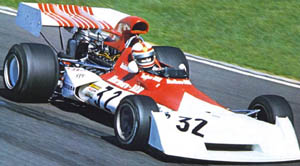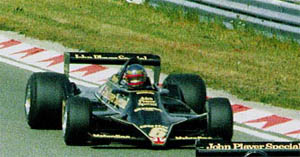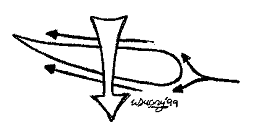|
| |||
 |
Taking the Lid Off F1 Formula One Technical Analysis | ||
| by Will Gray, England | |||
|
Atlas F1 presents a series of articles by certified engineer Will Gray, that investigates in greater depth all the technical areas involved in design, development, and construction of a Formula One car.
Aerodynamicists just can't get enough of that wonderful downforce! The more force on the car they can get from the air, the more force there is on the contact patches of the tyres, and the more grip the tyres can create. So how do they do it? To explain, I shall use the most simple aerodynamic device - the wing.
This, of course, is what an aeroplane uses to fly, but it wasn't until the 70's that someone had the bright idea of turning it upside down so that the lift it creates to pull the aircraft up from the runway can be used to push the racecar down onto the track. And so began the change in direction for F1 aerodynamics. Previously, designers had aimed to minimise drag with smooth shapes, but now, the F1 car is anything but a smooth, drag efficient vehicle, as downforce takes priority.
A clever man named Bernoulli discovered that if air increased in speed, it decreased in pressure and vice versa, so the faster air underneath the wing will be at a lower pressure than that on top of the wing. The pressure difference sees higher pressure above the wing which will force it downwards - downforce! The rest of the car works in a similar way - for instance, the floor is designed so that the air below it is of lower pressure than that above, and it will be forced downwards.
Everything is simple for an aeroplane, high in the air, but for the racecar there is another important aerodynamic element to consider: Ground Effect. Running so close to the ground, the carís aerodynamics are affected in a very positive way - for example, when a wing is positioned close to the ground, its downforce is increased, and its drag reduced. The ground effect Lotuses of the late '70's used this principle to most dramatic effect, but any aerodynamic device close to the ground will be assisted by this phenomenon.
Now, somehow, the aerodynamicist must quantify all these forces. As mentioned, downforce is due to pressure differences above and below objects, and drag is covered by the three factors mentioned in the previous section. However, both forces are related by similar equations, which contain similar parameters: Density, Velocity, Frontal Area, and Coefficient of Lift or Drag.
This leads to the annoying fact that if an engine maker gives the car more power, the car will go faster, but because the car is going faster it will have even more drag to contend with, and so more power will be needed to overcome the extra drag! Along with the speed, the other item concerned with the flow is its density. The denser the air, the more particles it contains, so the more force it will create. Density itself, however, is a factor of temperature and altitude, and hotter or higher climates will make the air less dense. This means that with different tracks situated at different heights and every day being a different temperature, the variables in aerodynamics are numerous.
Added to this equation are the factors associated with the object. It was noted in the previous section that the frontal area was important in the amount of drag produced, and this fits into the equation, along with what is termed the 'Drag Coefficient' - a value which says how slippery the shape is. This is the same for downforce, only using the 'Coefficient of Lift', which quantifies the objects ability to produce lift or downforce (negative lift).
When looked at simply, the equation is easy to understand. The density and speed of the flow make up what is known as its dynamic pressure, and this pressure is pushed onto the frontal area of the vehicle. The coefficient then determines how much downforce or drag the car will create. To get the best car, an aerodynamicist must minimise drag and maximise downforce - the job is never ending, and often frustrating, but itís one of the most crucial in the business.
Previous Parts in this Series: Parts 1 & 2 | Part 3 | Part 4A | Part 4B | Part 4C | Part 5A | Part 5B | Part 6A | Part 6B | Part 7A | Part 7B-1
|
| Will Gray | © 2000 Kaizar.Com, Incorporated. |
| Send comments to: gray@atlasf1.com | Terms & Conditions |


